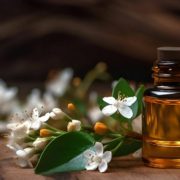Thoughts from Timbuktu – fixatives
Our customs evolve as generations pass, but the words of our language endure, often taking on different meanings and becoming misleading.
A century ago, perfumes were primarily used on handkerchiefs, scarves, and gloves rather than directly on the skin as they are today. There is a significant difference between the concepts of “the perfume is my dress” and “the perfume is myself.” “The perfume that is myself” is applied to the skin, becoming part of one’s identity, while “the perfume that dresses me” is meant for the clothing we wear.
The animal pheromones originally used in perfumery are designed by nature to be long-lasting. These territorial sexual pheromones, which males leave on their territory, serve to establish boundaries with other males while also attracting females of their species. Being fragrant, they function as perfumes in every sense. These aromatic chemical compounds have evolved to withstand the ravages of time, adverse weather conditions, sun, cold, and rain.
They are characterized by their ability to emanate pure sensuality as territorial sexual pheromones and exhibit extreme persistence. This offered a double advantage to the perfumers of the past, who utilized them lavishly. Much like the evolved animals that we are, these pheromones impart durability to fragrances, synonymous with quality. Examples include civet, castoreum, ambergris, beeswax, hyraceum, and musk deer.
However, there is one problem.
Pheromones are produced by the animal kingdom and are typically applied to rocks, trees, and leaves, but not to human skin. The animal fixatives that worked well for perfumes sprayed on handkerchiefs are not effective for modern perfumes applied directly to the skin. Substances like castoreum and civet last significantly shorter durations on our necks or wrists compared to materials such as patchouli or ylang-ylang. They would not work as fixatives if they were used in modern perfumery.
Despite this, the myth of fixatives, carefully maintained by fragrance manufacturers, persists to this day. Guy Robert, the renowned creator of perfumes like Madame Rochas and Diorissimo, famously stated, “The durability of a perfume is not easy to achieve, and nobody knows how to do it. I hate and find stupid the idea of fixatives.” (Refer to Guy Robert’s work, “Biogenesis of a Perfume” for more insights.)
On the other hand, synthetic musks, Ambroxan, and Cetalox—often referred to as synthetic ambers—along with chemical castoreum, exhibit exceptional durability on the skin. Why is this? It is primarily due to their incompatible nature with the human body, meaning they are difficult for the body to eliminate. As a result, they tend to accumulate in natural filters such as the skin, brain, liver, and kidneys, leading to easily foreseeable consequences.
These new synthetic molecules, which are predominantly absent in nature, may last longer but do not possess true fixative properties. According to Guy Robert, perfume fixation is a challenging and somewhat mysterious process that allows the entire scent to linger over time. In essence, it binds the different elements together, whereas synthetic molecules tend to last longer than the other fragrance components, often resulting in a flat base note being the only scent left after a few hours.
To genuinely enjoy wearing perfumes that are not overwhelmingly powerful or persistently nauseating, we might consider returning to the philosophy of “the perfume that dresses me” rather than “the perfume that is myself.” This shift could lead us to use more natural fragrances and apply them to our clothing instead of directly on our skin.
It’s worth considering that a scent meant to emanate one’s personality should be more exclusive, as every individual is unique. However, today, perfumes are mass-produced products. This leads to fashion brands manufacturing stereotypes, allowing individuals to identify not as unique beings, but as members of a club, caste, or group.
The prevailing model in perfumery often revolves around themes of seduction, luxury, and sex—an overly simplistic view not only of perfume itself but also of human existence. Many perfume advertisements seem to be crafted by teams lacking a coherent philosophical foundation.
As our customs evolve, so do our philosophical models, resulting in perfumes increasingly resembling chemical concoctions marketed through aggressive media persuasion. A housewife may be convinced to wear a certain perfume to feel like the young, beautiful model depicted in the advertisement.
Before realizing that instead of attracting others, your perfume might actually repel those with refined taste, a hundred new seduction-centric fragrances will be launched each season, perpetuating the illusion of “the perfume that is myself.”
Perhaps it is time to return to the original philosophy of “the perfume that dresses me,” allowing us to seek alternatives beyond the narrow narrative of seduction, luxury, and sex that dominates modern perfumery.
























Leave a Reply
Want to join the discussion?Feel free to contribute!